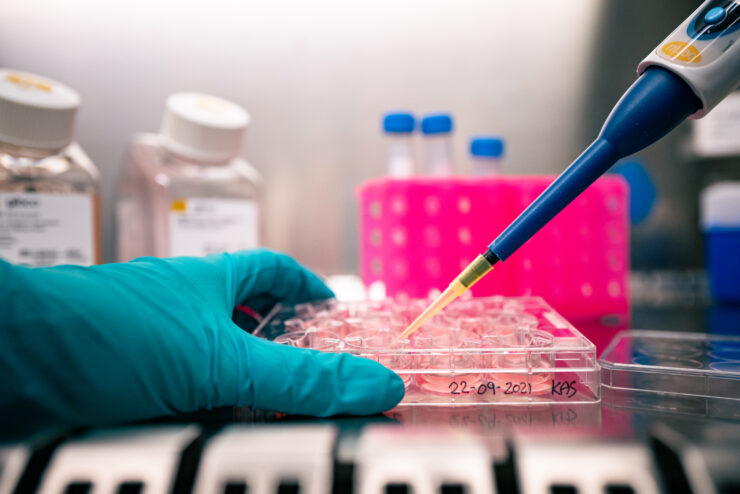News
RECAP SYMPOSIUM: Microplastics and human health research in The Netherlands – State of the Science

This publication provides a recap of the online symposium ‘Microplastics and human health research in The Netherlands’ that was held on 4 November 2021. About one hundred researchers and policymakers exchanged knowledge about the latest research results from fifteen breakthrough projects within the ZonMw research programme ‘Microplastics and Health’. Attention was also paid to MOMENTUM, Microplastics & Human Health Consortium, the new public-private consortium that has arisen from the breakout projects.
Importance of research
Symposium moderator Juliette Legler opened the symposium with general information about ZonMw’s programme Microplastics & Human Health. Programme manager Frank Pierik provided further details about the programme and emphasised its intended objectives. He drew attention to the impact of microplastics on our health and the importance of health research into micro-and nanoplastics (MNPs). The breakthrough projects will be followed up in MOMENTUM.
Project coordinator Juliette Legler and co-coordinator Dick Vethaak emphasised the size of the consortium, which has 27 partners that come from both industry and research. The three-year funding of MOMENTUM has been provided by ZonMw, TNO, Health~Holland, Top Sectors and private partners such as UMC Utrecht, the National Institute of Public Health and the Environment (RIVM), KWR Water Research Institute, the Ministry of Infrastructure and Water Management and the Ministry of Health, Welfare and Sport. The consortium will continue health research into microplastics, from a toxicological perspective, starting with the characteristics of MNPs, the exposure scenarios and, finally, the risk assessment.
Effects of small particles
The introduction was followed by an apt double keynote lecture. What can we learn from other disciplines where small particles play a role? Paul Borm (Nanoconsult) gave us insight into the behaviour of small particles from the perspective of nanotechnology. The surface, shape and size of small particles determine their behaviour. It is also important to include the dose and concentration in the final risk assessment.
Flemming Cassee (RIVM/Utrecht University) continued the keynote with the effects small particles have inside our bodies. Nanoplastics reach the internal organs faster than microplastics. However, we still know little about the long-term effects of chronic exposure and the amount of plastics that can accumulate in the body.
“There is a strong indication for the presence of the particles in the placenta and amniotic fluid”
Plastic particles in the circulatory system, organs and tissues?
In the subsequent session, the latest research results were presented about the uptake, transport and toxicology of MNPs in cell culture models. Various models must answer the question as to whether and to what extent MNPs reach the circulatory system, human organs and tissues. Heather Leslie (VU Amsterdam) investigated the presence of MNPs in the circulatory system and concluded that follow-up research is needed into plastic particles in the circulatory system. Combined with the initial results from Hanna Dusza (Utrecht University/IRAS) there is a strong indication for the presence of the particles in the placenta and amniotic fluid.
Toxicologist Hans Bouwmeester (Wageningen University and Research) provided a better understanding of the release and transport of chemicals that leach from MNPs, for example in the intestines. The potential risks associated with these chemicals for human health are expected to be significant to such an extent that follow-up research will be necessary. In addition, chronic exposure should be investigated too.
Free-riding pathogens
Besides the danger of MNPs and the possible release of chemicals, another risk is the presence of potential pathogens such as bacteria, viruses and fungi that catch a ride on the surface of the particles. Ana Maria de Roda Husman (RIVM) and Bas van der Zaan (Deltares) are investigating this. Differences in the presence of microorganisms are determined by the site where the microplastics are found. Beach litter proved to be the most microbiologically contaminated. Also, the hygienic conditions make a difference with respect to the encountered number of resistance genes: the genes that bacteria exchange to strengthen their resistance to antibiotics.
The response of the human immune system to the microbes present on microplastics was also investigated. The plastic particles with biofilms, which contain potential pathogens, gave a stronger immune response in a tested cell culture model.
Barbro Melgert (University of Groningen) described the dangers of the lungs being exposed to inhaled clothing fibres. As high exposure to microplastic fibres among textile workers has been associated with the development of lung diseases, the effect of polyester and nylon fibres on the lungs was investigated using model mini lungs (so-called organoids). Nylon or polyester fibres inhibited the growth of the mini lungs. Especially nylon was found to influence the growth phase of the lungs. The cause was found to lie in the chemicals released from the microfibres and therefore not in the nylon fibres themselves.
Effect of ocean plastics on the immune system
After a short break, the symposium continued with a presentation from toxicologist Yvonne Staal (RIVM). She investigated ocean plastics and plastics collected along the coast, and their effects on the human immune system. In the laboratory, immune cells in a cell culture were exposed to a range of ground plastic particles of different sizes. The conclusion was that the chemical composition, the number of particles and the particle size determine how strongly immune cells respond. The cell-killing effect of the immune system was stimulated the most by the smallest particles, up to 50 µm in size. Also, weathered particles, particles damaged by UV radiation or surface water, elicited a stronger response of immune cells. In particular, the chemical and physical properties of the particles determine the immune cell response.
“After just 24 hours, inflammatory proteins were measurable in the intestines in the presence of nylon fibres”
Microplastics in intestines and lungs
Evita van der Steeg and Ingeborg Kooter (TNO) examined the response of immune cells in the intestines. They developed a 3D intestinal tissue model and a 3D lung epithelial model to investigate the effect of microplastics on human and pig cells. They aimed to answer the question of whether the intestines and lungs can take up microplastics and what the possible biological effects are when this happens. Car tyres, ocean plastic, HDPE, polystyrene and nylon fibres were included in the study. The intestines absorbed about 6% of the tested particles and the lungs 4%. A moderate inflammatory response could be seen in both the lungs and intestines. After just 24 hours, inflammatory proteins were measurable in the intestines in the presence of nylon fibres. The barrier function of the intestines also decreased.
Annemijne van den Berg (Utrecht University, IRAS) and Nienke Vrisekoop (University Medical Center Utrecht) partially confirmed these results and performed additional experiments. Van den Berg discovered that allergic responses might occur after repeated (oral) intake of microplastics. Vrisekoop found that larger plastic particles are more rapidly encapsulated by the immune system than smaller particles but that, in general, not the size but the number of particles determines the strength of the immune response.
Knowledge gaps
The last session focused on creating awareness with respect to existing gaps in research into MNPs. This session started with a keynote lecture and closed with a panel discussion.
Keynote lecture
In his keynote lecture, Bart Koelmans (Wageningen University and Research) emphasised the complexity of the risk assessment for MNPs. The actual risk of exposure to MNPs is difficult to calculate as not all the risk parameters are known. And these include not just the risks of the plastics, but also the chemicals and microorganisms that are associated with these. Koelmans is therefore building a risk assessment model with parameters such as particle size, concentrations, and inhalation, intake and uptake rates. Other important factors are the part of the plastic that is not taken up, tissue size, and the part of the plastic that is excreted via the urine or intestines. To find out what the chemicals do, it is also important to know how many chemicals are released into the intestines during a human life. Excretion and uptake in the intestines play a role too, because plastic particles can release chemicals and pick them up again.
The huge diversity in microplastics and the lack of key data, such as the surface of the particles and internal exposure concentrations, make the development of a risk model enormously complex. Such a model needs to be developed, however, to determine how exposure to microplastics affects human health. The figures in the lab must also be comparable with figures about exposure to microplastics in the air and via the intake of food.
Besides the uncertainty about the figures, there is also no consensus between experts regarding the reliability and use of all data. For example, what are permissible values for human exposure to plastic particles? Until that is clear, no policy can be developed in this area. In a nutshell, there are still many research questions that the MOMENTUM consortium needs to answer.
“Plastics are everywhere, and so everybody is continuously exposed to these”
Panel discussion about the research gaps
Following the poster presentations from the speakers and the private MOMENTUM partners in separate breakout rooms, knowledge gaps took centre stage during the last part of the symposium: the panel discussion. Dick Vethaak moderated discussions between the following panel members: Jeroen Geurts (ZonMw), Bart Koelmans (Wageningen University and Research), Flemming Cassee (RIVM), Paul Borm, Nanoconsult), Jane Muncke (Food Packaging Forum Australia), Lukas Kenner (Institute for Cancer Research Vienna) and Ardi Dortmans (TNO).
After a brief introduction from each panel member and their own input for the discussion, the panel members discussed the next steps in health research into MNPs. They also elaborated on the questions and uncertainties that emerged during the discussion.
Ardi Dortmans (TNO) emphasised the importance of translating research results into realistic information for people. Plastics are everywhere, and so everybody is continuously exposed to these. Despite this, the expected health risk at the individual level is not that great, but it is at the population level. According to Dortmans, we should therefore focus on prevention, in other words, how can we reduce the huge amount of plastic waste? He suggests, for example, new, reusable production possibilities for plastics.
According to Flemming Cassee (RIVM) and Paul Borm (Nanoconsult) there are still many unknown biological effects of MNPs, and we cannot proceed further until we know these. Information about chronic exposure is one such example. Many panel members agreed with this. With his keynote lecture, Bart Koelmans (WUR) had already clearly stated the knowledge gaps in this area. The first step is understanding the biological mechanisms and concentrations in the tissues before something can be said about the risks. Further research is needed to acquire this understanding.
Follow-up research is also needed because much of the knowledge in the literature, about 83%, is concerned with health research into polystyrene MNPs that are mainly used in packaging material. However, many more different types of plastic are present in our drinking water, food and the air. Consequently, too little data is available about the various MNPs to be able to properly set up the risk assessment.
Finally, Jeroen Geurts (ZonMw) added that the knowledge agenda ‘What do microplastics do in our body?’ clearly lists the knowledge needs for research, policy and innovation. The agenda also describes a strategy to develop applicable knowledge.
The discussion continued by stating that research into MNPs needs to be placed in a broader context because it not only concerns human health. How can people reduce the many plastics in the environment to satisfy the climate objectives of 2050 as well? One of the solutions is to reduce (food) consumption and with that plastic packaging, emphasised Jane Muncke (Food Packaging Forum). This can be achieved by, on the one hand, using less plastic and, on the other, by increasing recycling and reuse.
But, and that was possibly the most important conclusion, we will need to switch to entirely new materials as a substitute for plastic to reduce the accumulation of especially the smallest particles in the environment and the human body. Degradable polymers could possibly be the future, and so a collaboration with chemists who contribute their ideas is indispensable.
Closing remarks
Juliette Legler closed the symposium with the final conclusion that follow-up research into MNPs is needed to bridge the knowledge gaps identified. She thanked the keynote speakers, Flemming Cassee and Paul Borm, for sharing their knowledge about the research field of small nanoparticles, and Bart Koelmans for the first concrete steps towards risk assessment.
All of this information is highly relevant to establish the risks to human health. Juliette also briefly summarised the research results and the role of the MOMENTUM consortium in following up on these.
National and international collaborations are vital for fully describing the risk assessment and dangers of MNPs. Juliette called on MOMENTUM participants to establish the necessary collaborations with European projects. Finally, the participants were invited to the informal virtual drinks and networking and thanked for their attendance.
More information
- More information about the ZonMw programme and the 15 Microplastics & Health projects can be found at https://publicaties.zonmw.nl/microplastics-health/
- To examine the relationship between microplastics and the ZonMw-wide subject Healthy living environment, please see our publication ‘Healthy living environment’.




